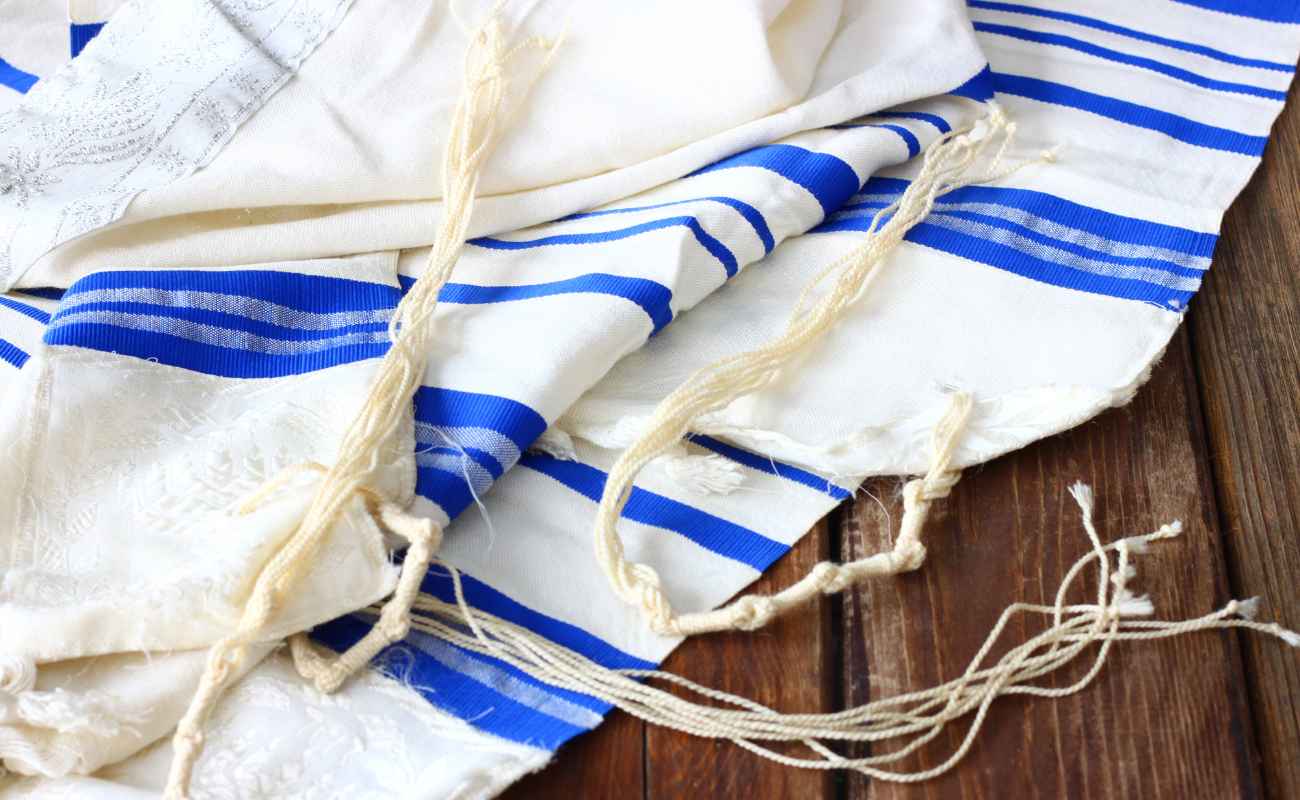what is Tallit for Chuppah?

Tallits (prayer shawls) are an integral part of Jewish tradition and should be worn during morning prayers and holidays.
The tallit is a rectangular mantle-like garment with fringes (tzitzit) attached to each corner for easy recognition of God's commandments. These fringes serve as a constant reminder to uphold them.
What is a tallit for wedding?
Tallits are traditional prayer shawls worn during daily morning services by religious Jews. Men typically don them, although many women also choose to wear one. Tallit fabrics typically comprised of wool are used, although other materials may also be utilized.
Jewish couples' wedding ceremonies are an extraordinary momentous milestone in life, and tallit are used as symbolic objects during them. Given as gifts from bride to groom or included as family heirlooms in the chuppah (Jewish wedding canopy).
As part of their Jewish wedding ceremony, couples often wrap a tallit chuppah around each other's shoulders during their chuppah ceremony to symbolize unity and love between themselves – an act known as tallit chuppah that has become an indispensable tradition.
The tallit is a symbol of faith and identity for the Jewish people and an essential component of religious practice. As such, it should be treated as an object worthy of being treated with great reverence and taken great care to safeguard.
In many Jewish communities, a boy receiving his tallit for the first time at their bar mitzvah will wear and use it throughout Yom Kippur services and during daily life.
Jewish traditions necessitate that men and boys wear tallit at certain occasions, like during weddings. This is particularly evident within Orthodox and Ashkenazi communities where boys must wear both the tallit gadol (long-sleeved version) and tallit katan (short-sleeved version) versions simultaneously during ceremonies.
Tzitzit are an integral symbol of Judaism and fulfill the biblical commandment for Israelites to wear fringed clothing on all four corners.
Most tallits designed for use during Jewish practice are composed of wool for kosher reasons; however, other materials including silk and cotton may also be used.
Tzitzit can be produced either by machine or hand and tied by a rabbi according to his nusach (custom). They come in many different sizes and shapes and can even be customized by adding Techailis — blue string from Murex Trunculus Snail — which adds color.
Who wears tallit at a wedding?
People may not realize it, but a tallit is one of the most important items for religious Jews. With origins dating back to biblical times and becoming an integral part of Jewish culture, prayer, and ritual since its introduction into society over 2000 years ago.
The tallit (pronounced tallis depending on dialect) is a prayer shawl often worn by Orthodox and traditional Jewish men, although its wear may also be prevalent among more liberal Jews as well as non-Orthodox Jewish individuals, although wearing one isn't required in every situation.
Tallitot are white cloth garments made of wool, cotton or silk and richly decorated with Jewish symbols and embellishments. Additionally, fringes called tzitzit add an additional decorative element.
Orthodox and traditional Jewish people must observe a mitzvah to wear a tallit at all times during the day, including when praying. Wearing one while praying is particularly essential.
Tallit gadol, or four-cornered shawl, is the traditional attire. It may be given as a present from either the bride's family or she herself.
While traditional Jewish custom requires men to begin wearing tallit gadol only after marriage, Eastern European Jewish men often start donning it earlier and more widely accepted by Ashkenazi communities.
Tallits are sacred garments worn as an emblem to represent one's spiritual journey and marriage transition. Symbolizing that transition from singlehood to marital union, tallits form an integral component of Jewish wedding ceremonies as part of the chuppah (portable ark). A tallit is worn around one's shoulders during religious wedding ceremonies as part of this religious practice and also used for other religious celebrations such as circumcision.
Furthermore, it serves as the ritual garment for the hora, an iconic Jewish wedding dance typically performed immediately upon entering or shortly after the couple has had their first dance at receptions or ceremonies.
At any Jewish wedding ceremony, the tallit is traditionally wrapped around both newlyweds to signify their shared commitment to one another's future together. This traditional gesture makes for an exquisite and meaningful tradition.
Can children wear tallit?
Tallit chuppahs are one of the most beloved and sacred rituals at any wedding, symbolized by new beginnings, rebirth and life itself. Children do not need to wear one but often choose to. Furthermore, tallits make an enduring and meaningful present to give someone you care about on this special day.
Tallit is a prayer shawl which features fringes (tzitzit) attached to its four corners to satisfy biblical commandment regarding fringed garments, according to which fringed clothing must have fringes attached at their corners and ends in accordance with biblical verses. Tzitzit can come in various colors, patterns and knots.
A tallit is a rectangular shawl made of wool, linen or silk and worn during morning prayers or special events such as holidays and celebrations. While traditional color may be white or black for different communities, white remains the standard hue.
Tallitot with black stripes on their outer surface have come to symbolize mourning for Jerusalem's ancient Temple that was destroyed in 70 C.E.; others may opt for white tallits in order to symbolize new beginnings and symbolize resurrection.
Tallits typically made of wool are considered kosher; however, cotton or synthetic fiber tallits can also be considered acceptable as long as they meet standard Jewish kashrut certification criteria.
Some travelers like to use a tallit bag when travelling with their tallit. These portable and secure storage solutions help protect the fabric. Some families even use them during the day at home while not attending synagogues or praying.
Women may not be required to wear prayer shawls or tallits in certain parts of the world; however, they can still choose to recite Shema each morning and night or fulfill Sukkot mitzvot at any time they wish.
At Bar Mitzvah or before, Jewish males in Western Europe and Islamic lands begin wearing tallitot (four-cornered garment) under their shirt as part of everyday attire. It typically forms part of their attire for at least part of each day.
Why buy a handmade tallit for chuppah?
The tallit is an integral component of Jewish ritual, worn for morning prayers and Kol Nidre services during Yom Kippur evening services. It can be made of linen, wool or silk.
Tallitot are traditionally worn by both women and men as prayer shawls and symbolic representations of faith.
Though a tallit is not required for wedding ceremonies, its presence can enhance the atmosphere of any special day. Depending on its style of celebration, its design could range from intricate embroidery to vibrant colors – adding that special something that only can come from being part of something bigger.
If you plan on wearing a tallit at your wedding, a handmade one should be considered. Quality tallits will last much longer.
Custom-made tallises can be purchased either locally at Judaica stores or online from many of them, though the costs tend to be slightly higher; nonetheless, this keepsake will help commemorate your wedding day in style!
When purchasing a tallit, it is wise to opt for one constructed of high-grade fabric as this will extend its longevity and become a prized possession over time.
As well as purchasing your tefillin, it is also recommended that you invest in a matching tefillin bag to make wearing and transporting the garment more comfortable and effortless.
Handmade tallits add special meaning and character to your chuppah ceremony, reflecting both your personal style and that of your wedding. Each design can represent something about its owner or reflect the theme of their special day.
Some brides and grooms opt to decorate their chuppahs with flowers that reflect their taste, while those planning outdoor ceremonies may wish to use weatherproof floral arrangements that won't get damaged during their special day.
Flowers should complement your color scheme perfectly and add depth and dimension to the wedding venue. Choose shades that enhance both the canopy and venue setting for optimal effect.
No matter the complexity or simplicity of the flowers you select, they should all look stunning on the chuppah. A classic floral arrangement would include roses or hydrangeas; alternatively, add other types to create a distinct look.
